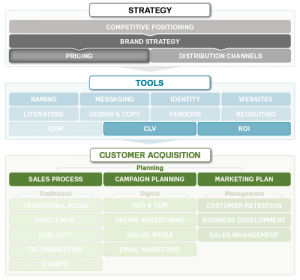
Do you know the margins you have to work in? Pricing is one of the classic “4 Ps” of marketing (product, price, place, promotion). It’s one of the key elements of every B2C strategy.
Yet for many B2B marketers, the pricing strategy in their marketing plan is challenging to write; many aren’t even involved in creating their pricing strategy.
There are many factors to consider when developing your pricing strategy, both short- and long-term. For example, your pricing needs to:
- Reflect the value you provide versus your competitors
- Match what the market will truly pay for your offering
- Support your brand
- Enable you to reach your revenue and market share goals
- Maximize your profits
Pricing Strategy:

When you offer a truly unique product or service with little direct competition, it can be challenging to establish your price. Define a strong strategy and competitive analysis so you can view:
- What your prospects might pay for other solutions to their problems
- Where your price should fall in relation to theirs
When your price, value proposition and positioning are aligned, you’re in the best situation to maximize revenue and profits.
Deviating from Your Pricing Strategy
If sales are slow, many companies lower their price. That’s not always the best option. Here are three price change examples:
| HIGHEST PRICE | AVERAGE PRICE | LOWEST PRICE |
|---|---|---|
| Company A is one of the best consulting firms in the world. Their consultants come from top schools, and they work with Fortune 100 clients to implement complex, large-scale projects.Company A’s value proposition is product leadership. Their clients are buying the best expertise they can find, and they’re less sensitive to price because they care most about getting top talent.
Therefore, Company A’s services can be priced as high or higher than their competitors. |
Company B’s value proposition is operational excellence, so their price is important. There’s a lot of competition and their product is only slightly better than the alternatives.Company B’s messages focus on their product value with a secondary focus on price. They regularly review the market, run promotions, and adjust prices to maintain their competitive position.
The company is also working to develop a premium product that can warrant a higher price. |
The market cares most about price because the product is viewed as a commodity.Company C focuses on finding new ways to lower costs and pass savings on to customers. Their value proposition is operational excellence and they consistently deliver the same product at a better price.
Company C regularly evaluates their competitors’ prices to make sure they’re delivering on their promise. If a competitor runs a promotion, Company C counters with a better one. |
What would happen if these companies used a different pricing strategy?
| HIGHEST PRICE | AVERAGE PRICE | LOWEST PRICE |
|---|---|---|
| By dropping their hourly rate, Company A gains more clients. They hire more consultants, but since they’re charging less per hour, they can’t afford the same top-tier talent.Company A is putting their “prestige” brand in jeopardy.
However, if there isn’t a strong market for prestige, this strategy may be the best one for the company long-term. |
If Company B charges a premium price for an average product, they’ll have a very difficult time generating interest in their it.Yet Company B may be able to implement a small price increase to raise revenue and profits; it depends how much more its customers are willing to spend.
By analyzing price sensitivity and testing different prices, they can evaluate the strength and potential of this new strategy. |
If Company C’s prices rise in relation to those of their competitors, sales will plummet – their market is shopping on price, not factors like product leadership or customer intimacy.If Company C cannot maintain its operational efficiency and cost leadership, it will need to develop new products or markets for its existing product. |
Do you see your company in one of these scenarios?
| Best Case | Neutral Case | Worst Case |
|---|---|---|
| Company A provides a premium product, sold through carefully-selected retail outlets.Their pricing is typically 15% above the competition – they’re the most expensive product in their class.
Their demand curve is relatively inelastic, meaning that their market isn’t that sensitive to price. Much of that results from the carefully selected positioning and branding over the past five years. |
Company B charges an average price for an average product.When they’re behind their sales targets, individual reps are given the green light to discount if needed to meet their sales quotas.
Management doesn’t want to get in a price war, but is willing to ensure that they hit their short-term numbers. Management knows that they could spend more in R&D to differentiate their offering and have greater pricing power, but they haven’t yet committed the budget to do so. |
Company C provides business consulting services.To grow, they drop their hourly rates by up to 40%. This gives them access to an entire new set of clients.
Low rates mean they can’t afford the same top-tier consulting talent. The quality of their offering suffers, and they end up providing mediocre service for both markets. By lowering the price of their “prestige” brand to access a new market, Company C has increased its revenue, while reducing its profit margin and damaging its brand. |
Not Sure Where to Start with Your Pricing Strategy?
Pricing Strategy Key Concepts & Steps
Before you begin
It’s best to define your positioning, create your brand strategy, and identify your distribution channels before you develop your pricing strategy in the marketing plan. By doing so, you’ll ensure that your pricing reflects your value and reinforces your brand.
For example, if your method for delivering value is product leadership, you shouldn’t discount heavily or compete on price; you should also minimize pricing conflicts with any channel partners.
Your pricing influences how the market perceives your offering. If you’re perceived as a commodity, you must either change the market’s perception via a new positioning strategy, or compete on price and focus on innovating to keep costs low so you can still make a profit.
Match your pricing strategy to your value proposition
Your price sends a strong message to your market – it needs to be consistent with the value you’re delivering.
- If your value proposition is operational efficiency, then your price needs to be extremely competitive.
- If your value proposition is product leadership or customer intimacy, a low price sends the wrong message. After all, if a luxury item isn’t expensive, is it really a luxury?
Understand your cost structure and profitability goals
Companies calculate these costs differently, so verify the exact calculations your company uses for
- Cost of goods sold (COGS): the cost to physically produce a product or service
- Gross profit: the difference between the revenue you earn on a product and the cost to physically produce it
In addition, understand how much profit the company needs to generate. You’ll be far more effective when considering discount promotions – you’ll know exactly how low you can go and still be profitable.
Analyze your competitors’ prices
Look at a wide variety of direct and indirect competitors to gauge where your price falls. If your value proposition is operational efficiency, evaluate your competitors on a regular basis to ensure that you’re continually competitive.
Determine price sensitivity
A higher price typically means lower volume. Yet you may generate more total revenue and/or profit with fewer units at the higher price; it depends on how sensitive your customers are to price fluctuations. If they’re extremely sensitive, you may be better off at a much lower price with substantially greater volume.
Estimate how sensitive your customers are to fluctuations – it will help you determine the right price and volume combination. More importantly, you can estimate how a price change can impact your revenue.
After Designing Your Pricing Strategy
Once you’ve finalized your pricing strategy in the marketing plan, it’s time to design your marketing campaign
What do you think about your own pricing strategies? Have you covered your production and service costs? Are your prices in-line with your long-term business goals? If you would like to comment on this article or learn more about my consulting project management work, please visit me at my personal website www.tonycrilly.com

10 Crilly Management Consulting Case Studies
Please, share your thoughts in the comment area below.








